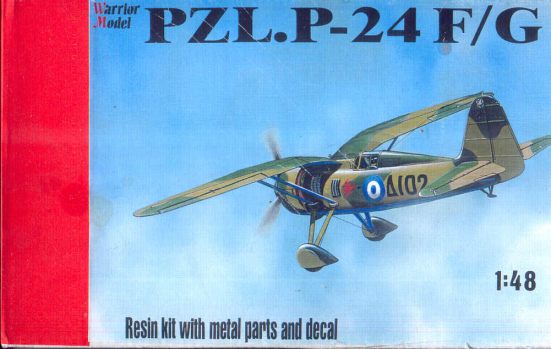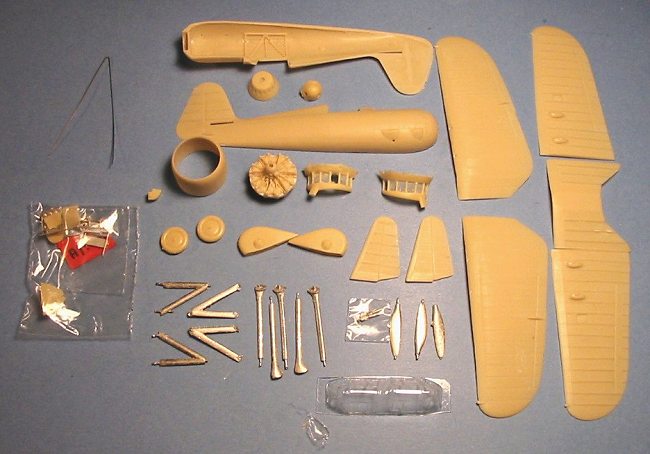
|
KIT: |
Warrior Models 1/48 PZL P.24F/G |
|
KIT # |
48006 |
|
PRICE: |
$64.95 |
|
DECALS: |
Two aircraft |
|
REVIEWER: |
|
|
NOTES: |
Resin with metal parts |

|
HISTORY |
It is not well known, but in the late 1920s and up through the mid 1930s, the Polish aviation industry was sat least as good as any other, and ahead of many in terms of adapting advanced technology and creating first class aircraft. The State Aviation Factory, PZL, had the services of a gifted designer, Zygmunt Pulawski, who was responsible for a considerable advance in the state of the aviation art.
At the time of the first appearance of Zygmunt Pulawski's P.1 in 1929, it was the most advanced fighter in the world. In 1930, the second prototype, flown by Col. Jerzy Kossowski, would win 8 first places of 15 possible at the International Fighter Contest in Bucharest. Unfortunately, the pace of aircraft development in the following decade would be such that by the time the final development of this record-setting design saw combat, the series was sadly obsolete. Nevertheless, flown by pilots who refused to accede to defeat, Pulawski's fighters managed to write an indelible chapter in air warfare.
The P.24 was first suggested in 1932, as a development for the export market. While basically the same airplane as the domestic P.11c fighter, the use of a new type number was seen as "good marketing." The Gnome-Rhone "Mistral-Major" two-row 14-cylinder radial of 700 h.p. was adopted for the prototype, which first flew in May, 1933. In March, 1934, the second prototype P.24 set an FAI record of 257.24 mph.
Progressive development of the engine resulted in the Gnome-Rhome 14 Kfs, with 900 hp, which was adopted for the P.24III. Armed with two 20mm cannon and two .30 cal. machine guns, it was exhibited at the 1934 Salon de Paris as the heaviest-armed fighter in the world, and aroused considerable interest. Evaluation teams from Bulgaria, Estonia, Yugoslavia, Greece, Romania and Turkey examined the fighter. In 1936, Romania and Turkey ordered the first P.24s. By this time, it was realized that the Pulawski design, with a gulled and braced wing and fixed undercarriage, was becoming passe in comparison with later designs now entering production in other countries.
Several deals fell through, but in 1937, both Bulgaria and Greece ordered cannon-armed P.24Fs and 4-machine gun armed P.24Gs, and Turkey modified its contract to get airplanes to the same standard. The 20mm cannon of the P.24F did such damage to the structure when fired that all of the Greek P-24Fs were re-equipped with a 4 machine gun armamament in 1939, to P-24G standard. The P-24G was produced with a Gnome-Rhone 14N 07 of 950 hp and a low-drag NACA cowling, with armor glass windscreen and back armor for the pilot, and four Browning machine guns.
Following the Italian attack on Greece on October 28, 1940, the 25 operational P.24Gs of the Greek Air Force gave very good account of themselves against the incompetently-led Italian forces during the six month struggle that ended with the Germans crushing Greece.
|
THE KIT |

Tadeusz Bialowski, who is "Warrior Models," is a skilled craftsman when it comes to creating masters and molds for limited run resin kits with excellent surface detail. With the PZL P.24G, he has outdone himself, as the "Wibault" corrugations on the wings and horizontal stabilizer are the best representations of this strange construction method I have seen done by anyone to date.
The 42 multi-media - resin and white metal - parts are well-designed, and the molds are so good that only a small amount of cleanup is necessary to be ready to start assembling the kit.
 Fit is excellent. It
would appear from my test-fitting that no putty or Mr. Surfacer will be
necessary for the 5-part wing, and that only a bit of cyanoacrylate glue and Mr.
Surfacer will be needed to get rid of the fuselage centerline seam.
Fit is excellent. It
would appear from my test-fitting that no putty or Mr. Surfacer will be
necessary for the 5-part wing, and that only a bit of cyanoacrylate glue and Mr.
Surfacer will be needed to get rid of the fuselage centerline seam.
The cockpit of this series was quite spartan, and the parts provided in the kit are more than sufficient to provide an accurate and detailed look to this area.
|
CONCLUSIONS |
It is unlikely that this version of the PZL "gulls" will be likely to show up as an injection-molded plastic kit (though Mirage Hobby might surprise us). If you like the out-of-the ordinary, this is an excellent model that will look good sitting next to your Mirage Hobby PZL P.11c. This goes to the top of my "to do" pile.
Thanks to Warrior Models for the Review Kit. Get yours from Pacific Coast Models.Review kit courtesy of my kit collection.
If you would like your product reviewed fairly and quickly by a site that has well over 150,000 visitors a month, please contact me or see other details in the Note to Contributors.
Back to the Previews Index Page